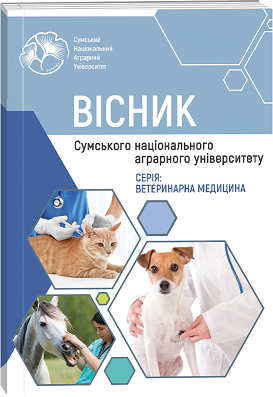Вплив технології виробництва молока на його якість та безпечність
Анотація
В статі наведені дані санітарно-гігієнічного стану ферми при виробництві молока за традиційних та за новітньої технології. В даній роботі були проведені дослідження мікроклімату у приміщеннях для корів та його вплив на якість та безпечність молока. Нашими дослідженнями встановлено що якість та безпечність молока напряму залежить від технології його виробництва. За використання новітньої технології виробництва молока кількість соматичних клітин та загальне обсіменіння молока не перевищувало 221,1тис/см3та 70,8 КУО тис/см3 відповідно. Разом з тим з’ясовано що за використання новітньої технології виробництва молока в зимовий період часу температура в приміщення може опускатися до -100С, але це не приводить до збільшеності захворювання на мастит та органи дихання. Захворювання корів на мастит не перевищує 6,4 відсотка що є одним із кращих показників.
Посилання
2. Arulraj, P., Asarudheen, I., Jasmin, T., Mohammed, Sarfas, Sahnas, N.K., Vedha, Satheesh, Venkatanarayanan, R., 2015. Dairy bacteriology and microbial analysis of milk using syringe filter. European Journal of Biomedical and Pharmaceutical Sciences 2, 380-388.
3. Busato, A., Trachsel, P., Schallibaum, M., Blum, J.W., 2000. Udder health and risk factors for subclinical mastitis in organic dairy farms in Switzerland. Preventive Veterinary Medicine 44, 205-220. [CrossRef]. DOI: 10.1016/s0167-5877(00)00104-5
4. Dorofeev, O. V. and Buncev, V. E. (2015), “The role of staff in ensuring competitive advantages of the agrarian enterprose”, Antropologihni aspekty upravlinnia suhasnym pidpryemstvom : vseukrainska naukovo-praktyhna Internet-konferenzia [Anthropological aspects of management of a modern enterprise : Ukrainian scientific and practical Internet-conference], PDAA, Poltava, Ukraine.
5. Dufour, S., Frechette, A., Barkema, H.W., Mussell, A., Scholl, D.T., 2011. Invited review: effect of udder health management practices on herd somatic cell count. Journal of Dairy Sciences 94, 563-579. [CrossRef]. DOI: 10.3168/jds.2010-3715
6. Hulich, M.P. (2011), “Balanced diet and healthy lifestyle − key factors maintaining the health of the population”, Problemy starenyia y dolholetyia, vol. 2, pp. 128−132
7. Hussain, R., Javed, M.T., Khan, A., 2012. Changes in some biochemical parameters and somatic cell counts in the milk of buffalo and cattle suffering from mastitis. Pakistan Veterinary Journal 32, 418-421.
8. Joshi, S., Gokhale, S., 2006. Status of mastitis as an emerging disease in improved and periurban dairy farms in India. Annals of the New York Academy of Sciences 1081, 74-83. [CrossRef]. DOI: 10.1196/annals.1373.007
9. Kernasyuk, Y. (2015), “Robotized cow milking: recoupment of investments”, Online, availableat : http://www.agro-bisiness.com.ua/suchasne-tvarynnytstvo/3978.html (Accessed 15 Oct 2017).
10. Kostenko, V. (2013), “Milking of cows, evaluation and selection of firstlings”, [Online], available at: http://www.agro-bisiness.com.ua/suchasne-tvarynnytstvo/1530.html (Accessed 15 Oct 2017)
11. Kostenko, V. (2015), “Economy of milk production”, [Online], available at : http://www.agro-bisiness.com.ua/suchasne-tvarynnytstvo/3171.html (Accessed 15 Oct 2017).
12. Kyryliuk, I. (2016), “Current approaches to guarantee the quality and safety of animal products in the EU”, Efektyvna ekonomika, vol. 12, available at: http:// http://www.economy.nayka.com.ua/?op=1&z=5330 (Accessed 03 Sep 2017)
13. Lelieveld, H.L.M., Holah, J., Gabric, D., 2016. Handbook of Hygiene Control in the Food Industry, (Woodhead Publishing Series in Food Science, Technology and Nutrition), 2nd Edition, Woodhead Publishing.
14. Livestock Production Technology (2005), “Milking of cows”, [Online], available at : http://buklib.net/books/34166/ (Accessed 15 Oct 2017).
15. Lucenko, M. and Zvoleyko, D. (2012), “Research of the process of milking cows in the specialized milking parlours”,Technika i technologyi v APK, , vol. 9(36), pp. 31–34.
16. Lucenko, M. and Zvoleyko, D. (2013), “Efficiency of using robotized milking systems”, Technika i technologyi v APK, , vol. 5(44), pp. 13–15.
17. Ma, Y., Ryan, C., Barbano, D.M., Galton, D.M., Rudan, M.A., Boor, K.J., 2000. Effects of somatic cell count on quality and shelf-life of pasteurized fluid milk. Journal of Dairy Sciences 83, 264-274. [CrossRef]. DOI: https://doi.org/10.3168/jds.S0022-0302(00)74873-9
18. Shkromada, O., Palii, A., Palii, A., Skliar, O., Dudchenko, Y., & Necherya, T. (2019). Improvement of milk quality for micro-climate formation on cattle farms. Bulletin of Sumy National Agrarian University. The Series: Veterinary Medicine, (4 (47), 43-49. DOI: https://doi.org/10.32845/bsnau.vet.2019.4.7
19. Mankiewicz, R., 2004. The Story of Mathematics. Princeton, NJ: Princeton University Press.
20. Marshall, R.T., 1992. Standard Methods for the Examination of Dairy Products, 16th ed. American Public Health Association, Washington, DC.
21. Murphy, S.C., Boor, K.J., 2000. Trouble-shooting sources and causes of high bacteria counts in raw milk. Dairy, Food and Environmental Sanitation 8, 606-611.
22. Otenko, V. I. (2014), “Competitive advantages of business activities”, Biznes inform, , vol. 4 (435), pp. 290–295.
23. Smolar, V.I. (2013), “Formula nutrition”, Problemy kharchuvannia, vol. 2, pp. 5−9.
24. Zamoyski, K. Zamoyski, C. Wilczynski, J. and Chorna, O. (2014), “Nutrition students”, Naukovi zapysky: Pedahohichni nauky, vol. 132, pp. 319−323.

Ця робота ліцензується відповідно до Creative Commons Attribution 4.0 International License.

 ISSN
ISSN  ISSN
ISSN 



